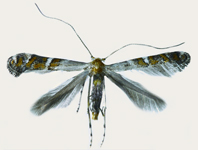Abstract
Elpidium ostracods are known by their very particular niche (water accumulated in tank-bromeliads), their relatively low dispersal ability and their dependency on amphibians for dispersal and colonization of new bromeliads. All these characteristics make the genus an interesting group for evolutionary, ecological and even taxonomic studies. However, the diversity of the group remains poorly studied. Here, we describe three new species of Elpidium, Elpidium littlei n. sp., Elpidium heberti n. sp. and Elpidium wolfi n. sp., and re-describe Elpidium laesslei, all from Jamaica. These species are characterized by a copulatory process with separated ejaculatory duct and distal glans, a feature so far unique within the genus. Each species can, in turn, be diagnosed by soft part and carapace morphology, most notably comparing hemipenis, valve ornamentation and degree of sexual dimorphism. The observed morphological diversity of Elpidium is discussed in relation to previous genetic estimates that suggested an even higher diversity in Jamaica. We point to intraspecific variation and lack of complete morphological descriptions as possible explanations. We also reaffirm the need of multidisciplinary studies in order to do more objective and secure taxonomic classifications in future studies.
References
Armstrong, H. & Brasier, M. (2005) Microfossils. Blackwell Publishing, Oxford, 296 pp.
Benzing, D.H. (2000) Bromeliaceae: profile of an adaptive radiation. Cambridge University Press, Cambridge, 675 pp.
Cohen, A.C., Martin, J.W. & Kornicker, L.S. (1998) Homology of Holocene ostracode biramous appendages with those of other crustaceans: the protopod, epipod, exopod and endopod. Lethaia, 31, 251–165.
https://doi.org/10.1111/j.1502-3931.1998.tb00514.x
Colin, J.P. & Danielopol, D.L. (1980) Sur la morphologie, la systématique, la biogéographie et l’évolutiondes ostracodes Timiriaseviinae (Limnocytheridae). Paleobiologie Continentale, 11, 1–51.
Danielopol, D.L. (1975) Remarques sur la diversification morphologique de trois especes d'Elpidium (Ostracoda) a Cuba. Bulletin of American Paleontology, 65 (282), 47–60.
Danielopol, D.L., Pinto, R.L., Gross, M., Pereira, J.S. & Riedl, N. (2014) On the evolutionary biology of Elpidium ostracods (Limnocytheridae, Timiriaseviinae): a proposal for pluridisciplinary studies. Geo-Eco-Marina, 20, 87–129.
Horne, D.J., Cohen, A. & Martens, K. (2002) Taxonomy, morphology and biology of Quaternary and living Ostracoda. In: Holmes, J.A. & Chivas, A. (Eds.), The Ostracoda: Applications in Quaternary Research. American Geophysical Union, Geophysical Monograph Series, Washington, D.C, pp. 5–36.
https://doi.org/10.1029/131GM02
Jocqué, M. & Field, R. (2014) Aquatic invertebrate communities in tank bromeliads: how well do classic ecological patterns apply? Hydrobiologia, 730, 153–166.
Jocqué, M., Fiers, F., Romero, M. & Martens, K. (2013) Crustacea in phytotelmata: a global overview. Journal of Crustacean Biology, 33 (4), 451–460.
https://doi.org/10.1163/1937240X-00002161
Kitching, R.L. (2001) Food webs in phytotelmata: “bottom-up” and “top-down” explanations for community structure. Annual Review of Entomology, 46, 729–760.
https://doi.org/10.1146/annurev.ento.46.1.729
Little, T.J. & Hebert, P.D.N. (1996) Endemism and ecological islands: the ostracods from Jamaican bromeliads. Freshwater Biology, 36, 327–338.
https://doi.org/10.1046/j.1365-2427.1996.00094.x
Lopez, L.C.S., Gonçalves, D.A., Mantovani, A. & Rios, R.I. (2002) Bromeliad ostracods pass through amphibian (Scinax perpusillus) and mammalian guts alive. Hydrobiologia, 485, 209–211.
https://doi.org/10.1023/A:1021315223774
Lopez, L.C.S., Rodrigues, P.J.F.P. & Rios, R.I. (1999) Frogs and snakes as phoretic dispersal agents of bromeliad ostracods (Limnocytheridae: Elpidium) and annelids (Naididae: Dero). Biotropica, 31 (4), 705–708.
https://doi.org/10.1111/j.1744-7429.1999.tb00421.x
Martens, K. & Savatenalinton, S. (2011) A subjective checklist of the recent, free-living, non-marine Ostracoda (Crustacea). Zootaxa, 2885 (1), 1–79.
https://doi.org/10.11646/zootaxa.2855.1.1
Martens, K., Schön, I., Meisch, C. & Horne, D.J. (2008) Global diversity of ostracods (Ostracoda, Crustacea). Hydrobiologia, 595, 185–193.
https://doi.org/10.1007/s10750-007-9245-4
Müller, F. (1880) Descrição do Elpidium bromeliarum crustáceo da família dos Cytherideos. Archivos do Museu Nacional, Rio de Janeiro, 4, 27–34.
Pinto, I.D. & Purper, I. (1970) A neotype for Elpidium bromeliarum Müller, 1880 (type species for the genus) and a revision of the genus Elpidium (Ostracoda). Escola Geológica de Porto Alegre, 19, 1–23, pls. I–XI.
Pinto, R.L. & Jocqué, M. (2013) A new species of Elpidium (Crustacea, Ostracoda) from bromeliads in Cusuco National Park, Honduras. Zookeys, 313, 45–59.
https://doi.org/10.3897/zookeys.313.4904
Sabagh, L.T., Dias, R.J.P., Branco, C.W.C. & Rocha, C.F.D. (2011) New records of phoresy and hyperphoresy among treefrogs, ostracods, and ciliates in bromeliad of Atlantic forest. Biodiversity Conservation, 20, 1837–1841.
https://doi.org/10.1007/s10531-011-0050-z
Sabagh, L.T. & Rocha, C.F.D. (2014) Bromeliad treefrogs as phoretic hosts of ostracods. Naturwissenschaften, 101, 493–497.
https://doi.org/10.1007/s00114-014-1178-y
Srivastava, D.S., Kolasa, J., Bengtsson, J., Gonzalez, A., Lawer, S.P., Miller, T.E., Munguia, P., Romanuk, T., Schneider, D.C. & Trzxinski, M.K. (2004) Are natural microcosms useful model systems for ecology? Trends in Ecology and Evolution, 19 (7), 379–84.
Tressler, W.L. (1941) Ostracoda from Puerto Rican bromeliads. Journal of the Washington Academy of Sciences, 31, 263–269.
Tressler, W.L. (1956) Ostracoda from bromeliads in Jamaica and Florida. Journal of the Washington Academy of Sciences, 46, 333–336.

